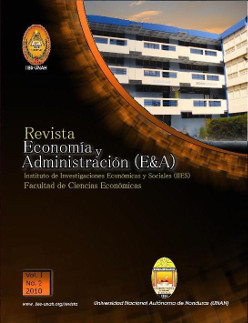Sistema de manufactura reconfigurable y competitividad industrial
DOI:
https://doi.org/10.5377/eya.v1i2.4352Palabras clave:
Práctica Avanzada de Producción, Reconfigurable ManufacturingSystem, RMS, High Performance Manufacturing, HPM, contingenciaResumen
Este artículo ha decidido usar un modelo dinámico de competitividad de la Producción de Alto Rendimiento (High Performance Manufacturing, HPM), que presentelas condiciones actuales en el escenario industrial a nivel mundial,para la futura implementación de Sistemas de Manufactura Reconfigurable (Reconfigurable Manufacturing Systems, RMSs). Así pues, aunque los RMSs pueden ser esenciales para la mejora continua, la globalización ha hecho difícil ganar ventaja (o aún paridad) competitiva a largo plazo con sólo implementar tales sistemas innovadores. Ello se debe en parte a la incesante e impredecible (y a veces predecible) evolución de las estructuras de mercado, de las demandas y de la tecnología de productos y de procesos. Por tanto, puede ser arriesgado el hacer predicciones de posibles rendimientos del impacto de futuros RMSs, desde mucha de la literatura teórica y empírica relacionada con el tema. Además, la evidencia de estudios empíricos en HPM muestra que la piedra angular de la competitividad industrial no es crear una nueva tendencia, sino más bien mejorar continuamente al seleccionar y adaptar, según sea necesario, sólo las practicas avanzadas de producción (PAPs) que se ajusten al contexto especifico de la fábrica, estableciendo vínculos entre las PAPs existentes y las nuevas por instalar. Así pues, tomando el contexto del HPM, se establecen las condiciones actuales para la implementación del RMS. Finalmente, este artículo hace sugerencias en relación alRMSe identifica posibles direcciones para futura investigación.
Descargas
2239
Descargas
Publicado
Cómo citar
Número
Sección
Licencia
Los autores que publican en esta revista están de acuerdo con los siguientes términos:
- Los autores conservan los derechos de autor y garantizan a la revista el derecho de ser la primera publicación del trabajo al igual que licenciado bajo una Creative Commons Attribution License que permite a otros compartir el trabajo con un reconocimiento de la autoría del trabajo y la publicación inicial en esta revista.
- Los autores pueden establecer por separado acuerdos adicionales para la distribución no exclusiva de la versión de la obra publicada en la revista (por ejemplo, situarlo en un repositorio institucional o publicarlo en un libro), con un reconocimiento de su publicación inicial en esta revista.
- Se permite y se anima a los autores a difundir sus trabajos electrónicamente (por ejemplo, en repositorios institucionales o en su propio sitio web) antes y durante el proceso de envío, ya que puede dar lugar a intercambios productivos, así como a una citación más temprana y mayor de los trabajos publicados (Véase The Effect of Open Access) (en inglés).




